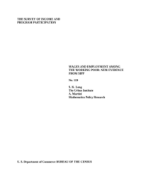
An official website of the United States government
Here’s how you know
Official websites use .gov
A .gov website belongs to an official government organization in the United States.
Secure .gov websites use HTTPS
A lock (
) or https:// means you’ve safely connected to the .gov website. Share sensitive information only on official, secure websites.
-
//
- Census.gov /
- Library /
- Census Working Papers /
- Wages and Employment Among the Working Poor: New Evidence from SIPP
Wages and Employment Among the Working Poor: New Evidence from SIPP
Wages and Employment Among the Working Poor: New Evidence from SIPP
Introduction
Of the 11 million persons aged 18 to 64 years who were in poverty in 1984, approximately 40 percent worked at some point during the year and 3.4 million were the sole or primary wage earner in the family. Among the latter group, about one in four worked year-round but were still unable to move their families out of poverty. While these full-year working poor represent a small fraction of the total labor force, as well as a small fraction of the population in poverty, the very fact that such workers cannot earn enough to support a family above the poverty line undermines the foundation of the American work ethic--the belief that "hard work pays off." Furthermore, at a time when welfare reform efforts are requiring recipients to join the workforce, the working poor are a reminder that moving off welfare is not necessarily a move to self-sufficiency. Clearly, if the earnings from full-time work are not adequate to move the worker's family out of poverty, much less to compensate for the loss of in-kind benefits associated with welfare receipt (particularly health care benefits under Medicaid), work is not necessarily a viable alternative to welfare.
In this paper we use the detailed labor force information available from the Survey of Income and Program Participation (SIPP) to examine wages, employment patterns, and sources of income among the working poor.(1) The paper is essentially descriptive. We make no attempt to identify the structural determinants of economic hardship among the working poor.(1) Existing theories and explanations for the persistence of poverty in the U.S. have been extensively reviewed by Sawhill (1988). Our goal is to exploit a new data source -- the SIPP -- to answer three questions:
- Among workers who have low annual earnings, which factors are associated with
remaining in or escaping from poverty? - What types of wage and employment patterns produce low earnings? In
particular, what is the relative importance of low wages versus low annual hours of
work? - Can this type of analysis offer background information that could aid in the design
of labor market and income support programs and policies which more effectively
target the working poor?
This paper is organized as follows. The next section addresses some methodological issues in defining the working poor population, while Section 3 illustrates the advantages of the SIPP relative to other data sources which are available for this type of analysis. Section 4 examines the relationship between low earnings and poverty status. Section 5 examines the wages and employment patterns among low earners, trying to identify the role played by low wages versus low annual hours of work. Section 6 conducts simple simulations of hypothetical changes in the wage and employment patterns observed among the working poor in order to examine the impact of these changes on poverty status. Finally, Section 7 summarizes our results and discusses directions for future research.
Others in Series
Working Paper
Working Paper
Working Paper
Share
Related Information
Some content on this site is available in several different electronic formats. Some of the files may require a plug-in or additional software to view.
 Yes
Yes
 No
NoComments or suggestions?


Top

